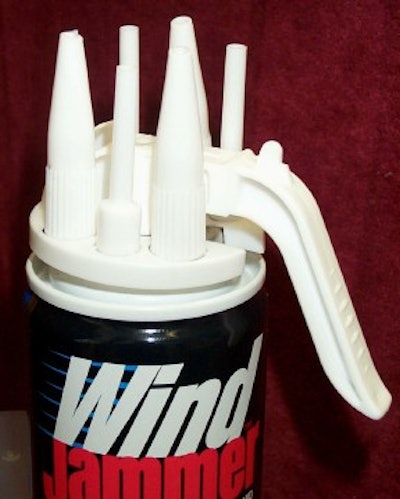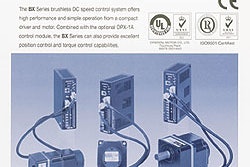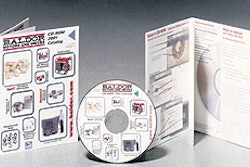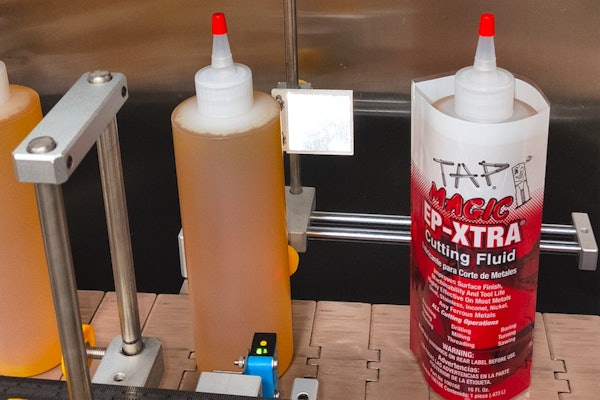
From the Liquid Nails division of Cleveland, OH-based ICI Macco, the product was promoted at the National Hardware Show, held in Chicago in August. "This was done for consumer convenience," states Scott Aiello, director of marketing. "One of the biggest problems for cartridge adhesives is that after use they [cure and] dry out. This product can be reused next time simply by changing the adapter and nozzle." The sealant is packaged with a set of three 1 3/4''-high adapters and nozzles injection molded in the form of a ring whose diameter is slightly less than the can's 2'' dia. A nozzle fits into an adapter that fits into the adapter orifice in the center of the can. The orifice extends through the trigger mounted over it. The dispensers are detachable from the ring's base, which rests atop the can. A hood molded over one end of the ring allows it to fit over the base of the trigger. The ring of dispensers, along with an ingeniously designed hinged trigger, fit inside an extra tall (3 1/4'') overcap. When not in use, the trigger folds up. A tiny fin in the trigger that fits into a slot on bottom, stationary portion locks it into place in the upright position. Unfolded for use, the trigger is about 4'' long, which makes it all the easier to dispense the product. In that position, a set of small bars molded on the trigger friction-fit into a cutout below the hinge to lock it into place. This attention to detail underscores the complex R&D effort undertaken by Macco manager of technical development Mark Stypczynski and his associates.
Material thoughts Stypczynski informs Packworld.com that the trigger and ring of dispensers are both injection molded of the same special polyolefin compound, which he declines to identify. Its selection was based on the hinged piece, which had to be flexible enough in that area to withstand repeated applications, notes Stypczynski. It was also used in the ringed dispensers "to keep things simple," he says. The pressurized can contains a clear removable weather sealant that can be used around windows to stop drafts. Graphics on the can side illustrate how to remove the ring, snap off a nozzle/adapter and fold down the trigger. The trigger itself is hinged; it folds down for use and snaps into place. The 2'' dia overcap has a clear pressure-sensitive label.
'Canny' innovation Another innovation would go unnoticed as it is in the can itself. "You may think that you've seen this kind of can before used for other products such those that contain latex or silicone," Stypczynski explains. "However, none of those are solvent-containing products because a conventional can couldn't be used. We've managed to solve that problem due to something in the [can]. And it's a competitive advantage." Stypczynski declines to provide further details. The can technology for solvent-based products debuted with WindJammer and three other similarly packaged products. WindJammer is contract packaged in "a standard filling process," according to Stypczynski, who says that the trigger, nozzle ring and overcap are all applied manually. "If volumes grow, there will be some modifications of that process," he adds.
Response 'seals' the effort Aiello says the market response to WindJammer "has been fairly strong. People are receptive to the fact that this new delivery system will allow them multiple uses. And they get nice pinpoint control with this product; with the nice nozzle tip they can get into some difficult locations, and dispense the product right where they need it. We're considering this for future products." Along with three other products, WindJammer was introduced in fall 2000 as part of the EZ NAILS line of adhesives and caulking materials that also feature the replaceable dispensers. The products retail for $4.95.


























